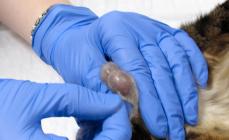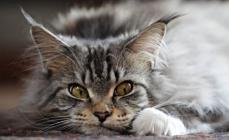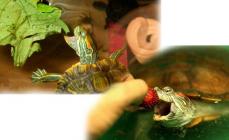Dogs and cats are traditionally eaten in some Asian countries, but what is more surprising is that 3% of the Swiss eat these harmless and cute animals. They eat cats in northern Italy and, of course, in Korea they are bred there and considered healthy food. Just like that.
Cats were always eaten when necessary. This is meat, and people eat meat especially when there is nothing to eat. Now I really only know for sure about China. They eat cats there and there are even a bunch of restaurants that serve cat meat dishes.
They love to eat cats in Asia, namely in China. They have always been famous for their unusual cuisine. And this tradition even appeared in America. There even began to appear recipes on how best to cook a cat. Perhaps this is just a joke, but even in our country, not very conscientious pie traders do not hesitate to make pies from meat of unknown origin. Cats are also eaten during wars and hunger strikes, but this is out of desperation, and not because of taste preferences. Fortunately, in many countries around the world, cats still remain pets and not a favorite food.
They definitely eat it in China. I know - there is a dish there called the Battle of the Tiger and the Dragon. It is prepared from a snake and a cat.
I was always confused by the expression: These are the pies with kittens! A suspicion involuntarily arises, why did this statement arise in the first place? It’s scary to even imagine, but it’s popular among Russian-speaking people, and, as they say, there’s no smoke without fire... maybe there were such hungry times... but I don’t want to believe it, of course.
I don’t know now, but they ate cats in besieged Leningrad when there was absolutely nothing to eat, they even ate sawdust and glue,
Well, if you managed to catch a cat, it was a blessing, in this miraculous way cats helped some gourmets survive, but now you can’t eat cats, because cats are useful animals, maybe even healthier than elephants.
In the small town of Chincha Alta, which is located on the coast of Peru, local residents still adhere to the centuries-old tradition of eating cat meat.
This strange custom arose during the colonization of the territory of present-day Peru by Spanish newcomers.
In Peru they eat cats.
The Indians, enslaved and kept on starvation rations, had to sustain their strength with such meat food. It was very rare to get other food, even vegetable food, so the savvy wives of slaves found similar options for their family to survive.
Those times have passed, it seems there is no longer a need for such an unusual diet, but the descendants of those tribes still happily eat stewed cats in local restaurants. Moreover, a cat baked in vegetables is considered a gourmet dish
There was a series called Alf. So, the main alien character said the famous phrase: You don’t like cats - you just don’t know how to cook them.
Well, or an aged Chianti would suit it...
Theoretically, any living creature is edible. We don’t argue about tastes, since the argument is always not in favor of the extraction.
One of the favorite dishes of the Chinese is boiled live cat (that’s what it’s called in Chinese). They believe that eating cat meat can cure asthma, improve health, and restore the balance of human yin and yang. Restaurants use barbaric methods of torturing animals. They are brought to a state close to death and immersed in boiling water. They think that the more suffering, the better the taste - the blood is completely absorbed into the flesh, then the cat's meat will taste great. Like this!!!
In our neighboring town, in an old village, they not only eat cats, they don’t even run dogs, they just run past. And I have heard more than once that cats were and are eaten in China, as the participants correctly wrote above. In general, I don’t understand this kind of food, but on the other hand, they generally eat other meat every day and don’t waste it.
It is almost certainly known that cats and dogs are eaten in China and Korea. There, in some places, people still live on the brink of poverty. And therefore, according to tradition, they eat absolutely everything that moves and everything that they can digest.
The Chinese eat cat meat because they believe it has health benefits. And they believe it according to their traditions. Cat meat costs 10 yuan, brain 30 yuan, intestines 50 yuan. The figures are given for half a kilogram. There is a cookbook in China with the heading Cat Dishes. In Italy they ate cats after the war.
Most civilized people shudder with horror to learn that the Koreans, Vietnamese and Chinese eat cats with the same appetite with which Europeans eat beef or poultry. How is it possible? After all, a cat is a purely domestic creature, it is our companion, friend, and family pet! This is disgusting and disgusting. But for Asians, the question “Can I eat cats” has long been resolved: “Of course. It’s not only delicious, but also incredibly healthy.” Let's take a closer look at the culinary preferences of cat lovers.

So, why and where do they eat cats consciously, knowing that it is cat meat on the plate? Of course, first of all, this is the birthplace of four great inventions - Celestial China. Eating snakes, scorpions, cockroaches, beetle larvae and unfortunate iguanas, which are butchered alive right in front of the buyer, is no longer shocking to anyone. But the fact that they eat cats in China causes either an attack of pity for the underappreciated rat catchers, or an attack of nausea (and more often than not, both). From the Cantonese recipe book you can learn how to properly butcher cats, how to prepare soups, stews and other cat dishes. The Chinese eat cats not as a special delicacy (although in recent years one can increasingly see exactly this wording in the media), but as inexpensive meat that is accessible to all segments of the population. Every Chinese can afford soup or fried cat meat, but for some reason dishes made from intestines and internal organs are much more expensive.

Of course, restaurateurs relish this phenomenon in a special way and make money out of thin air. In China, the popular dish “Battle of the Dragon and the Tiger” is snake meat plus cat meat with rice and vegetables. The “delicacy” costs quite a lot at minimal cost. Snakes are collected directly from the swamps. Cats are captured all over the country, stuffed by the hundreds into bamboo cages and transported by train to southern China, where a large number of cat lovers live. No expenses for raising animals - everything is “natural”.

If someone is indifferent to the fact that cats are eaten in China, then hardly anyone will remain indifferent to the method of killing animals. Cats, like dogs, are beaten to death with sticks and hung by the neck. It is believed that due to the huge amount of adrenaline in the blood, the meat becomes more tender and tasty...
In addition to the inhabitants of the Middle Kingdom, cats are eaten in Korea and Vietnam. Fortunately for the barbels, Koreans eat cats much less often than dogs. However, tourists should be vigilant, since to this day you can taste this “exclusive” in many restaurants in Korea. But the Vietnamese consume cat meat for health purposes, believing that this meat helps with asthma, tuberculosis, heart and other diseases. In the backyards of Vietnamese restaurants you can often see cages with assorted cats - a clear sign that you should not order meat from this establishment.
Various animal rights organizations regularly hold protests against the consumption of cat and dog meat. Some provinces in China have banned the sale of cat meat. The authorities are especially harsh against restaurateurs, ranging from large fines to prison sentences for violators. Fortunately, the new generation is voluntarily abandoning the creepy tradition: young people are embarrassed to admit that in childhood, out of ignorance, they ate the meat of cats or dogs, and are promoting a friendly attitude towards these animals.

It’s scary to imagine, but there are countries where they eat cats out of ignorance. To the horror of his compatriots, this includes Russia. The joke “buy three shawarmas - build a cat” is only partly a joke. Cat meat can actually be found in a delicious concoction wrapped in pita bread (as can dog meat). Can you guess in which country they eat cats, mistaking a cat carcass for a rabbit carcass? That's right, in Russia. But we are not alone: for example, a Brazilian woman will never buy a rabbit whose legs have been cut off, since it is by these that one can determine whether the merchant is trying to slip a cat instead of a rabbit.
Is there any benefit?
Asian nutritionists and epidemiologists regularly publish in the media, telling why cats should not be eaten. They refute the myths that cat meat supposedly has medicinal properties and can somehow help in the fight against the disease. In part, the publication of scientific data is another way to prevent a decline in the number of cats in Asian countries. After all, the disappearance of cats means an increase in the rodent population and huge losses associated with crop damage.
In recent decades, in the modern world, the issue of eating meat has become extremely acute. This is due, first of all, to the movements of various organizations advocating for animal rights. This situation led to the popularization of vegetarianism, and also gave impetus to a large number of scientific studies aimed at clarifying the issue of the benefits and harms of meat. The article will talk about where cats are eaten in Europe and other parts of the world.
Cat meat is taboo
Considering the questions of where cats are eaten, in which country, it should be said that in most parts of our planet, cat meat is considered taboo, that is, a food whose consumption for religious or social reasons is not welcomed and rejected. If any modern person in Western society is pointed to a certain dish and told that it is fried cat meat, then that person's hair will stand on end and, to put it mildly, he will lose his appetite. This reaction is purely psychological in nature and is associated with cultural values and the society in which a person grew up.
However, if the same words are said to, for example, a Chinese person, the reaction will be completely opposite, since in some areas of this Asian giant, cat meat is sold in markets and various delicacies are prepared from it.
Why is cat meat prohibited for consumption?
When asked where cats are eaten in Europe, it should be said that nowhere, since European Union legislation prohibits the consumption of meat from this domestic animal. There are two reasons for this: firstly, in Europe, cat meat is considered taboo, and secondly, this ban is related to sanitary standards. Unlike beef or pork, there are no sanitary checks for cat meat to check for any pests or disease vectors that could be dangerous to humans. Therefore, any trade in cat meat faces heavy fines and arrest.
A ban on eating cat meat in European countries does not mean that it is not eaten at all.
Swiss "duck"
A couple of years ago, information appeared on the Internet that in Switzerland a certain young chef Moritz Brunner opened a restaurant where he offers his visitors to try fried cat meat prepared according to his grandmother’s famous recipe. Moreover, in his video, Moritz assured that in Switzerland, the meat of this domestic fluffy animal is consumed by 3% of his compatriots.
In the end, it turned out that the video was a “duck” and that Moritz Brunner and the restaurant did not exist. The video was filmed specifically by one of the organizations advocating for animal rights, which, using the example of cat meat, promoted their slogans to stop eating this animal product altogether.
Italian scandal

And yet, questions about where cats are eaten, in which European country, are not without meaning. A striking example is Italy. In 2013, the Association for the Protection of Animal Rights raised the alarm because it became known that many restaurants in Rome and other major cities used cat meat in their dishes, which was passed off as domestic rabbit meat.
Why Italy? In the first decade of the 21st century, the country was experiencing an economic crisis, so some restaurants decided to use relatively cheap cat meat. As a rule, these are Chinese restaurants. Considering that in Rome alone in 2001 there were about 120 thousand stray cats, it is not difficult to guess where restaurants in Italy got their meat from. At the same time, the “cat business” was carried out not only in Rome, but also in many regions of the north of the country. All people involved in this case were sentenced to prison terms ranging from 3 to 18 months, as Italian law provides for this punishment for any abuse of domestic animals. However, there are still places in Italy where cats are eaten illegally.
Where else was cat meat consumed in Europe?

It is quite difficult to answer this question, since almost all countries ate cats. Cats came to Europe from eastern countries, and were introduced as a means of fighting rats. The rapid reproduction of these domestic predators was successfully used by people for their cuisine; this happened, as a rule, during periods of famine. In the Middle Ages, however, cat meat was considered a poor man's food.
If we consider recent history, we can say the following: it is known for sure that in 1940 in Germany the consumption of meat from dogs, cats and other animals, including animals from the zoo, was legalized. The same situation existed in Belgium, France, Austria and, of course, Italy in the periods after the First and Second World Wars.
Cat meat in Europe is still “little flowers”

If we expand the list of countries where cats are eaten beyond Europe, then we must say that there are currently 2 countries where the meat of this animal can be sold and bought legally. These are China and South Korea. You can also buy cat cutlets illegally in Vietnam, Tahiti and the Hawaiian Islands (US state).
In China, a country where they eat dogs and cats, for example, there are a lot of markets where they sell pet meat. Typically, these markets are located in the southeastern part of the country and in some of its northern regions. Here you can try a wide variety of dishes prepared using meat, which is prohibited in the rest of the planet.
As for South Korea, it is generally estimated that about 8-10% of the population consumes cat meat.

The struggle in Vietnam and especially in Tahiti with the commercialization of the meat of the animal in question has led to little; in Tahiti, dishes based on it are considered traditional and are too closely related to the culture of the peoples of the country. In Vietnam, as well as in South Korea and China, there are too many people, but very limited resources for raising, for example, piglets or cows, so pet meat will be in demand here for a long time.
However, in recent decades there has been a strong influence of Western culture on these countries, which has led to a significant reduction in the volume of trade in cat meat, and in some cases to its complete abandonment. A striking example is the ban on all trade in cat and dog meat in Taiwan in 2017.
Why do many organizations in the world oppose the consumption of animal meat?

If we take into account the countries where cats are eaten legally, then the whole problem lies not in the very fact of the ban on meat for Westerners, but in how the extraction takes place. The fact is that cats and dogs are literally abused before they are eaten. In particular, they are kept in cages for weeks and months and inhumane methods are used to kill them. That is why many animal rights organizations, and many citizens of different countries, oppose the consumption of domestic animal meat for human consumption.
The joyful event of the birth of offspring from a pet is often overshadowed by the inappropriate behavior of the mother cat. Instead of affection and care, the animal shows aggression towards the cubs and even eats them. There are many reasons why cats eat their kittens, and in each specific case it is necessary to find out and take measures to prevent the situation in the future.
Cannibalism is intraspecific predation when animals of the same species are able to eat each other. This phenomenon is widespread among fish, insects, and is often found in mammals. Moreover, females are more predisposed to cannibalism than males. The reasons in nature are related to hunger or its threat, a change in habitat. In the wild, eating her offspring is due to an adaptive type of behavior, when, in order to preserve all offspring, the mother eats sick and weak cubs. In domestic animals, the phenomenon of cannibalism is less common. Nevertheless, cases of eating their offspring are often observed in pigs, dogs, and cats.
Reasons why cats eat their kittens |
Rationale for behavior |
Exhaustion of the female during pregnancy |
Growing embryos require large amounts of protein from the mother. This leads to serious nutritional deficiencies in the cat. Protein starvation pushes the pet to eat its young, which are perceived by the animal as a source of protein food. The phenomenon is often observed in homeless, malnourished animals. The period of gestation is accompanied by intense leaching of minerals and vitamins from the mother’s body. The level of calcium in the blood decreases especially sharply after childbirth. This causes inappropriate behavior, mental disorder in the animal, and it can destroy its young |
Weakening maternal instincts |
Unfortunately, not all furry mothers show tender maternal feelings towards their offspring. For a number of reasons, many animals, especially first-time mothers, do not show proper attention and care to their newborns. In extreme manifestations, this can be expressed in the form of eating the cubs. A weakening of maternal instincts is often observed during caesarean section. With such an unnatural resolution of pregnancy, animals often suffer from a lack of developed maternal feelings and can eat their offspring. Postpartum eclampsia is often the reason why a cat kills her kittens |
Psycho-emotional disorders as a result of stress experienced during childbirth can cause cannibalism |
Inappropriate behavior of a pet in relation to cubs can be provoked by dissatisfaction with the conditions of birth: lack of a nest, its inadequacy for raising offspring, the presence of strangers and animals during childbirth, etc. The birth act itself is stressful, and unsatisfactory external conditions further aggravate the psycho-emotional disorder, provoking an inadequate perception of the babies. In this regard, newborn kittens should not be handled, as this can also lead to eating, since they no longer smell like their mother. |
The reason why a cat eats newborn kittens is often a lactation disorder |
In the absence of milk in a cat, protective mechanisms are activated in the form of cannibalism, associated with a powerful law of nature - natural selection. The female, at the level of instincts, understands that she does not have food resources in the form of milk, the offspring are doomed to death and must be destroyed. The same mechanism is triggered in case of development of breast pathology |
Hidden health defects in a newborn at the level of instinct in the mother can lead to the consumption of weak and non-viable offspring |
The cat has the ability to identify hypothermic kittens - babies with a low body temperature. Such cubs will not be able to survive, and in order to ensure the life of other kittens, the mother must destroy the weak one. This is an ancient mechanism of nature, which is not lost even by domestic animals. |
A cat can eat a kitten completely by accident |
After each baby is born, the mother gnaws the umbilical cord and eats the afterbirth. This behavior has deep roots in the wild environment: this is how the female cleans her nest and does not attract scavengers and predators to the birthplace of her offspring. In the process of gnawing the umbilical cord and destroying the placenta, the animal may accidentally eat the kitten |
Numerous causes of cannibalism in domestic cats indicate a complex mechanism of this phenomenon.
Reasons why daddy cat destroys offspring

 The cat drags the kitten to a secluded place
The cat drags the kitten to a secluded place Cannibalism is inherent not only to domestic cats, but also to cats. As a rule, the female hides her nest from outside animals. But often a cat finds it and destroys the offspring. At the same time, males kill not only strangers, but also their own cubs. One of the likely reasons why cats eat kittens is to stimulate the female to come into heat. If a cat that has given birth feeds its offspring, it will go into heat after 3 to 4 months. If the cubs die, estrus occurs almost immediately after the kittens die. This pushes males to destroy their offspring and thereby stimulate the female to go into heat.
Another reason why cats kill kittens is competition, the struggle for existence. Adult males perceive small kittens as future competitors for food resources, territory, and females. That is why they can destroy both other people's cubs and their own. Also for this reason, at the level of natural instincts, the mother cat tries to place the future nest in a secluded place, inaccessible to other animals.
Symptoms of cannibalism
The reason why cats eat their kittens is not always obvious to owners of furry pets. Knowing about the likelihood of cannibalism in domestic cats, both an experienced breeder and the owner should know the warning signs of this phenomenon. There are no clear signs indicating an animal’s tendency to destroy its offspring. The owner should be wary of the cat’s excessive activity before and after birth, anxiety, fussiness, and nervousness of the animal.
Is treatment possible?
Cannibalism is a pathological manifestation of natural instincts and cannot be treated. Breed does not affect the manifestation of pathological behavior.
Prevention measures
Experienced breeders, when detecting such inappropriate behavior in a cat, remove it from further breeding, since cannibalism is inherited. The many reasons why a cat strangles her kittens make them difficult to identify. In this regard, the following preventive measures should be followed:
- Balanced and nutritious nutrition for a pregnant female with the inclusion of vitamin and mineral supplements in food. A veterinarian will help you get recommendations on creating the optimal diet for pregnancy and after birth. Monitoring the level of calcium in the blood to prevent postpartum eclampsia should be done through clinical analysis, since both high and low levels of the mineral in the body are dangerous;
- Preparing the nest in a secluded, quiet and safe place, inaccessible to outside animals. A thick cardboard box or exhibition box is suitable for these purposes. The nest should be placed in a dark place. It should be dry and warm. This organization corresponds as closely as possible to the natural conditions inherent in the cat at the genetic level.
- Observation of the birth process of the pet. Unobtrusive help from the owner will calm the mother cat and allow her to control the cat. If aggressive and inappropriate behavior of the mother is detected, newborns should be isolated. The animal, on the recommendation of a veterinarian, may be prescribed sedatives to calm the nervous system.
- Availability of food and water after birth. Food resources should not only be freely available to the cat, but also in close proximity to the nest. This will reduce the mother’s nervousness about leaving her babies in the nest, allowing the animal to quickly get enough and eliminate protein deficiency.
Cannibalism in domestic cats is a serious mental disorder based on ancient natural instincts. An animal with a predisposition to eating its own offspring should be excluded from breeding and breeding. Cannibalism has no cure. However, taking preventive measures will allow you to avoid such complex psychological deviations.
Similar articles
The reasons for the birth of non-viable offspring are varied. If a cat gives birth to dead kittens, what to do in this case and how to prevent stillbirth in the future, owners should have an idea...


Remember that your diet should first of all be balanced. In nature, cats eat not only tenderloin, they also eat succulent plants, can feast on insects, frogs, or otherwise diversify their diet. If you decide to feed your pet natural food, make sure that its diet is balanced in proteins, fats and carbohydrates, and also contains foods that stimulate the digestive system.

You might be interested to know that pork can cause cirrhosis or pancreatitis, excessive consumption of raw fish threatens poisoning with a specific enzyme thiaminase, which leads to loss of appetite and even convulsions, and after regular feeding, metabolic processes are disrupted.

What you should never give
Of course, the diet can be designed so that it is varied and meets the needs of your pet. However, remember that diversification does not mean giving everything that comes to hand. Among the foods that are regularly present in the human diet, there are many that a cat may be interested in, but which should not be given to it under any circumstances. This includes everything fatty, spicy, salty, pickled and smoked. All these products, although they attract the minds with their aroma, can lead to metabolic disorders and diseases of the digestive system.
Many cats find confectionery products extremely attractive because they often contain milk cream. But treating pets with cakes, sweets and even condensed milk is strictly prohibited! Chocolate contains substances that are toxic to cats; in addition, carbohydrates are generally very poorly broken down by the digestive system of predators - cats simply do not have specialized enzymes for this.
Feed me!
A logical question arises - what to do when a cat asks you to treat it to something tasty from the table? There is only one answer - hold the line! In fact, animals often just want to attract attention to themselves, and are not starving to death, as is written in his sad look. Feed your cat before you sit down at the table and try to distract her from the contents of your plate as much as possible. If the animal understands that there is nothing good for it here, it will gradually stop trying to pity you.





